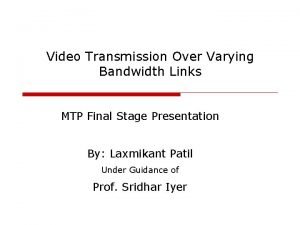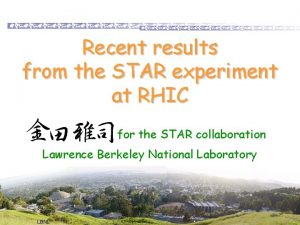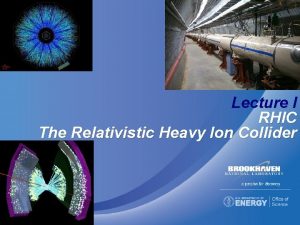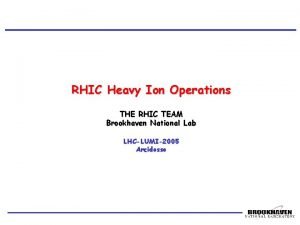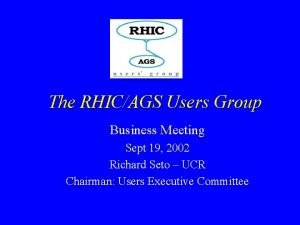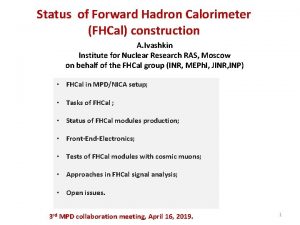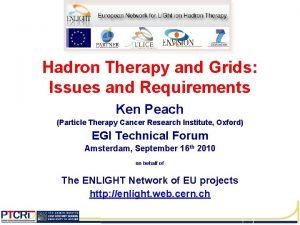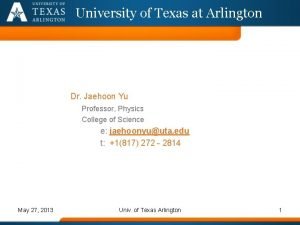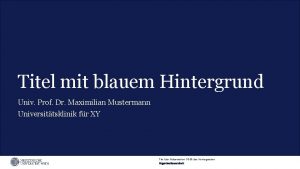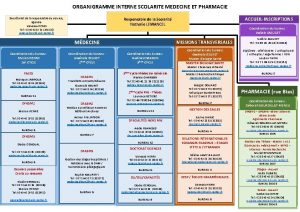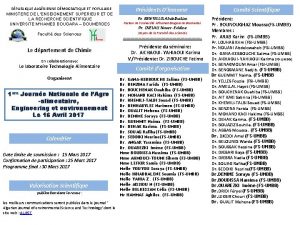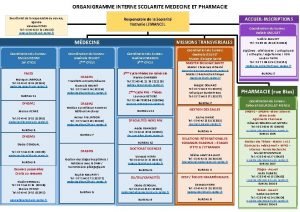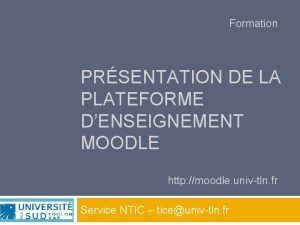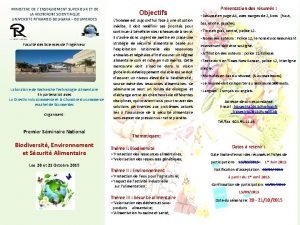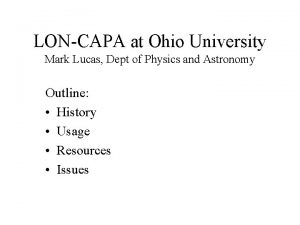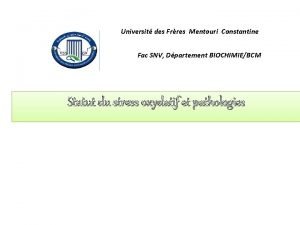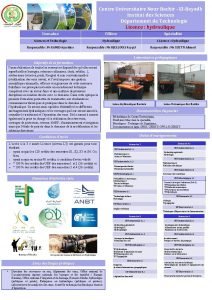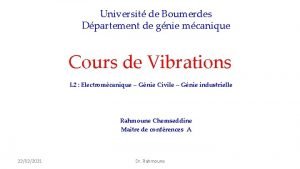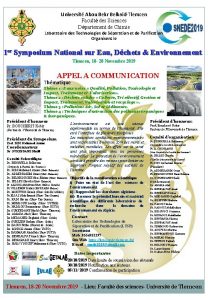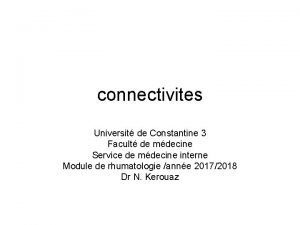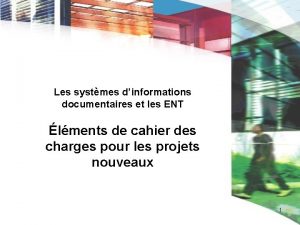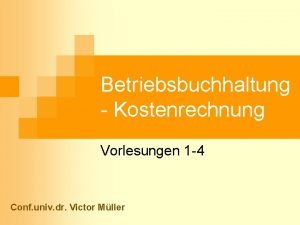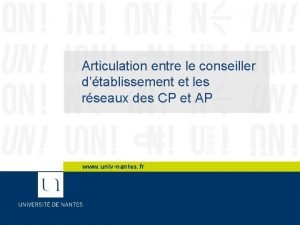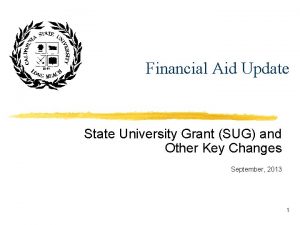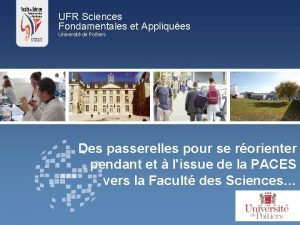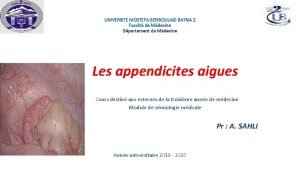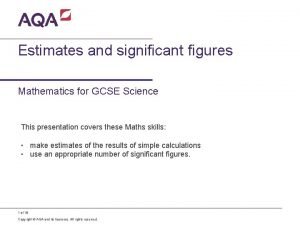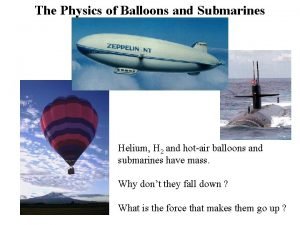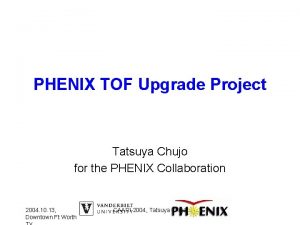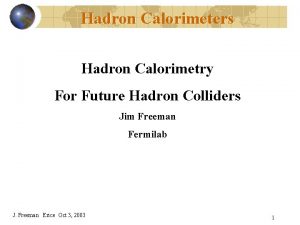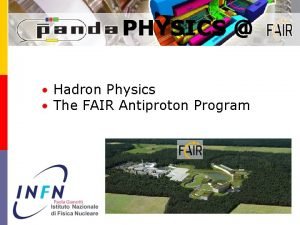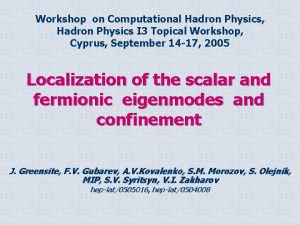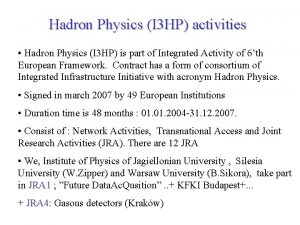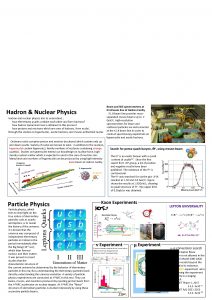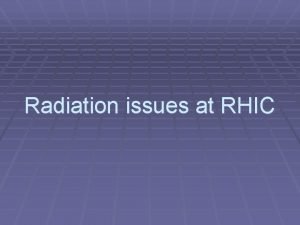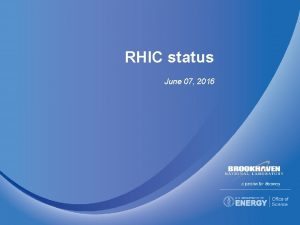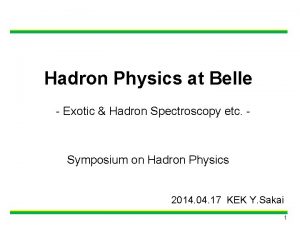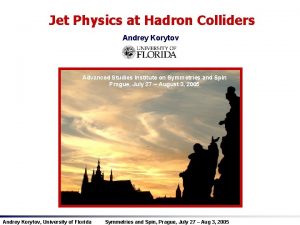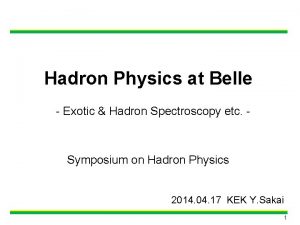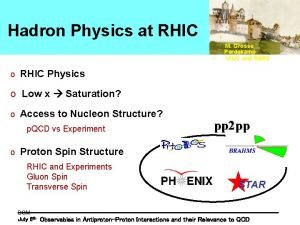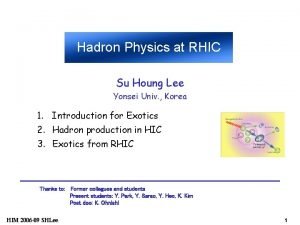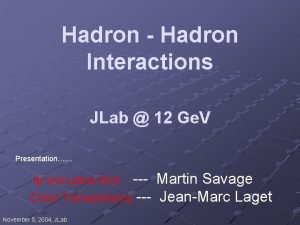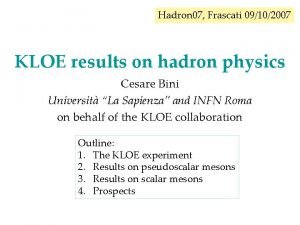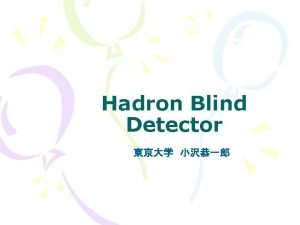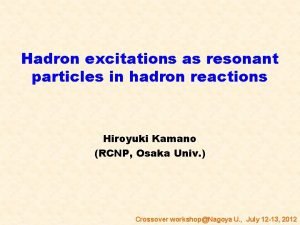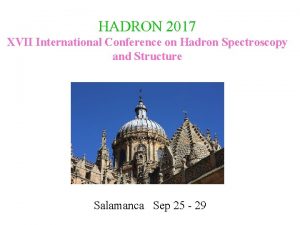Hadron Physics at RHIC Tatsuya Chujo Univ of




































- Slides: 36

Hadron Physics at RHIC Tatsuya Chujo Univ. of Tsukuba HAWAII 2005 2 nd DNP-APS/JPS Joint Meeting (Sep. 20, 2005) 1

I would like to thank to my great my colleagues and the PHENIX collaboration. 2

Article: Phys. Rev. C 69, 034909 (2004). • “Identified charged • • particle spectra and yields in Au+Au collisions at s. NN = 200 Ge. V” (PHENIX). A first PRC paper for /K/p spectra at 200 Ge. V Au+Au from RHIC experiments. Top-cite 100+ in SPIRES. 3

Physics overview of this article • To study the bulk properties of created matter at RHIC, explored as a function of collision centrality in Au+Au at s. NN = 200 Ge. V. – Particle productions (yields and ratios). – Radial collective flow. – Kinetic freeze-out and chemical properties. – Interplay between soft to hard process, discovery of Baryon-meson effect. • After the paper was released (2003), many reference data were also taken and analyzed. – – p+p @ s = 200 Ge. V (2003, 2005). d+Au @ s. NN = 200 Ge. V (2003). A+Au @ s. NN = 62. 4 Ge. V, 200 Ge. V (2004). Cu+Cu @ s. NN = 22. 5, 62. 4, 200 Ge. V (2005). • In this talk: – Review the current understanding of the hot and dense matter at RHIC from the hadronic view point. 4

Quark Gluon Plasma (QGP) Lattice QCD Calculations F. Karsch, Lect. Notes Phys. 583 (2002) 209. QGP phase Degrees of Freedom 8 gluons, 2 spins; 2 quark flavors, anti-quarks, 2 spins, 3 colors g = 37! (2 flavor) Pressure * Normal Nucleus: ~ 0. 2 Ge. V/fm 3, r ~ 0. 16 /fm 3 Heat QGP 5

Temperature Phase Diagram of Nuclear Matter Tc ~170 Me. V • QGP in Astrophysics Relativistic Heavy Ion Collisions Critical point Quark Gluon Plasma – Early universe: time < 10 -6 seconds – Possibly in the interior of neutron stars Early Universe Hadron Gas nuclei Color superconductor Color-flavor locking Neutron Stars? Baryon Density • QGP in Nuclear Physics –Create at the lab. by heavy ion collisions –Study the nature of QCD matter at the extreme temperature and energy density 6

Space-Time Evolution of System 4 3 2 1 1. 2. 3. 4. Hard scattering Thermalization and QGP Particle abundances fixed Particle freeze out (elastic Interactions cease) ♦ Photon: does not interact with matter strongly (penetrating probe) Hadrons: interact strongly (medium effect) ♦ 7

RHIC Basics: RHIC = Relativistic Heavy Ion Collider • 2 counter-circulating rings – 3. 8 km circumference – 1740 super conducting magnets • Collides any nucleus on any other • Top energies: 200 Ge. V Au-Au 500 Ge. V polarized p-p Flexible machine: Species (p+p, d+Au, Cu+Cu, Au+Au) Energies (19, 22. 5, 62. 4, 130, 200 Ge. V) • 4 Experiments 8

STAR 9

Outline • Is the energy density high enough? – Jets from hard scattering partons • How is hadronization process modified by the created matter? – “Baryon Anomaly” at RHIC and quark recombination • What are the bulk properties of the produced matter? – Elliptic flow and viscosity 10

Hard processes • Large momentum transfer at initial collision • Can resolve partons: valence quarks, sea • • quarks and gluons Fragmentation from partons to hadrons Coupling is weak – perturbative QCD applicable – Theoretically “hard” is “easy” • In Au+Au heavy ion collisions… – Scattered partons travel through dense matter – Partons loose their energy because of a large gluon density – Energy loss suppression of high p. T leading particles 11

Probes of the Medium (I) • Sometimes a high energy photon is created in the collision. • We expect it to pass through the plasma without pause. 12

Probes of the Medium (II) • Sometimes we produce a high energy quark or gluon. • If the plasma is dense enough we expect the quark or gluon to be swallowed up. 13

p. QCD Calibrated Probes (p+p) • Baseline measurements in p+p collisions at RHIC – Calibrated probes – Supported by well-established theory (perturbative QCD) Neutral pions Direct photon 14

Direct Photon Spectra in Au+Au • Now have a calibrated probe (good agreement of data and theory) • That works in the complex environment of two nuclei (Au+Au) colliding at high energies 15

Discovery of Strong Suppression (Au+Au) peripheral Ncoll = 12. 3 4. 0 central Ncoll = 975 94 Scaling of calibrated probe works in peripheral Au+Au, but strong suppression in central Au+Au 16

Determination of the Energy Density Nuclear Modification Factor d+Au ( 0) ~ Survival Probability in medium • To reproduce data by “Jet quenching” parton energy loss model: – Gluon density: d. Ng/dy ~ 1100 – Energy density: > 100 0 (!) e > 15 Ge. V / fm 3) Au+Au ( 0) Theoretical predictions: I. Vitev, nucl-th/0302002; I. Vitev and M. Gyulassy, hep-ph/0208108; M. Gyulassy, P. Levai and I. Vitev, Nucl. Phys. B 594, p. 371 (2001). 17

Baryon Anomaly at RHIC More (anti) baryons than pions at moderate p. T (2 -5 Ge. V/c). Does not look like vacuum jet fragmentation. (anti-) Proton / Ratio PHENIX: PRL 91, 172301 (2003), PRC 69, 034909 (2004) Central Factorization assumption of jet fragmentation completely breaks down. Peripheral 18

(Survival Probability) No suppression for protons • RCP ~ RAA • Shaded boxes : Npart, Ncoll determination errors. • p, pbar : No suppression at intermediate p. T (1. 5 Ge. V - 4. 5 Ge. V) • Why. Is it due to strong radial flow or other mechanism? 19

Other hadrons? baryon meson • The mesons and baryons form two distinct groups, • • independent of particle mass. Diverge at p. T ~ 2 Ge. V/c and come together at 5 Ge. V/c. Observed for first time at RHIC. 20

More on →K+K- RAA (new Run 4 data) • RAA (high statistics Run 4 data) looks like the π rather than the proton, even if mass( ) ~ mass(p)! • Suggested that it’s not the mass effect (flow). 21

Quark Recombination • The (normal) in vacuum fragmentation of a high momentum quark to produce hadrons competes with the in medium recombination of lower momentum quarks to produce hadrons • Example: – Fragmentation: Dq→h(z) • produces a 6 Ge. V/c from a 10 Ge. V/c quark – Recombination: • produces a 6 Ge. V/c • from two 3 Ge. V/c quarks produces a 6 Ge. V/c proton from three 2 Ge. V/c quarks Fries, et al, nucl-th/0301087 Greco, Ko, Levai, nucl-th/0301093 22

System size dependence: Cu+Cu @ 200 Ge. V p/ ratio in Cu+Cu/Au+Au Central Cu+Cu Baryon/meson ratio at 2 Ge. V in Cu+Cu scales as Npart. Rather is smooth transition from Cu+Cu to Au+Au. 23

Can We See Collective Behavior? • Simple answer: very high degree of collectivity is seen at RHIC. 24

Like a Perfect Fluid? • First time hydrodynamics without any viscosity describes heavy ion reactions. v 2 Lines: Hydrodynamics calc. with QGP type Eo. S. *viscosity = resistance of liquid to shear forces (and hence to flow) p. T (Ge. V) Thermalization time t=0. 6 fm/c and e=20 Ge. V/fm 3 25 Required QGP Type Eo. S in Hydro model

Quark Recombination on v 2 26

Quark Recombination on v 2 • Number of constituent quark scaling (n =2 for mesons, n =3 for baryons) works. • Pressure developed at quark level, not hadrons. • Key test with multi-strangeness baryons, e. g. W (small hadronic cross section). 27

Summary • • RHIC is a proven machine to study QGP! Many (unexpected) discoveries. Energy density: ~ 15 Ge. V / fm 3 , i. e. ~100 normal nuclear density. Gluon density: well above lattice QCD predicted transition level. Suggesting importance of quark recombination for hadronization in the medium. Behaving as zero viscosity “perfect” liquid. This is not the historical idea of weakly interacting gas of quarks and gluons. This instead is the creation of a strongly interacting Quark-Gluon Plasma (or Quark-Gluon Liquid). Open Questions to be answered: – – – Heavy quarks flow (the perfect fluid behavior). Thermal photon and initial temperature (constrain the degrees of freedom of QGP). Charmonium production (deconfinement) & high p. T PID v 2, spectra (fragmentation). Should be addressed in the future RHIC runs. 28

High p. T PID Upgrade Project in PHENIX TOF-West MRPC ( TOF ~100 ps) - Prototype installed and tested in Cu+Cu running. - Production type will be installed in Run 6 Aerogel Counter (n=1. 011) 29

Thank you for your attention. 30

BACKUP SLIDES

Analogy in Atomic Physics • Same phenomena observed in gases of strongly interacting atom M. Gehm, S. Granade, S. Hemmer, K, O’Hara, J. Thomas Science 298, 2179 (2002) The RHIC fluid behaves like this, that is, a strongly coupled fluid. 32

Thermal photons and temperature 33

0 RAA for 200 Ge. V Au Au Collisions 0 -10% 20 -30% New region for PHENIX 10 -20% 30 -40% PHENIX Preliminary 40 -50% Min. bias RAA appears flat all the way to p. T~20 Ge. V/c 34

RAA measured for Cu+Cu collisions PHENIX Preliminary PHENIX has analyzed high-p. T data for Run-5 Cu+Cu collisions only months after end of run 35

Viscosity • Viscosity h: – Viscosity depends on Temperature. – Ideal Hydro: small viscosity • (mean free path) << L (typical macroscopic scale) § Small viscosity Large cross sections, i. e. shear stress relaxes very quickly. = “strong coupled liquids” 36
 Tatsuya suda
Tatsuya suda Rhic
Rhic Rhic
Rhic Rhic brookhaven
Rhic brookhaven Rhic ags users meeting 2020
Rhic ags users meeting 2020 Hadron collider
Hadron collider Hadron
Hadron Hadron calorimeter
Hadron calorimeter Hadron
Hadron Hadron collider
Hadron collider Ent univ tours
Ent univ tours Ut arlington va office
Ut arlington va office Univ prof titel
Univ prof titel Celcat univ nantes
Celcat univ nantes Umbb inim
Umbb inim (univ. caxias do sul) escolha a alternativa que completa
(univ. caxias do sul) escolha a alternativa que completa Celcat univ nantes medecine
Celcat univ nantes medecine Logo université constantine 3
Logo université constantine 3 Moodle univ tln
Moodle univ tln Fs univ umbb
Fs univ umbb Lon capa ohio univ
Lon capa ohio univ Faculté snv constantine
Faculté snv constantine Centre universitaire nour el bachir el bayadh
Centre universitaire nour el bachir el bayadh Ch rahmoune
Ch rahmoune Dr abou bekr
Dr abou bekr Dysopyramide
Dysopyramide Iut valenciennes ent
Iut valenciennes ent Conf univ dr
Conf univ dr Prodoc univ nantes
Prodoc univ nantes Sug grant
Sug grant Httpsfa
Httpsfa Pharmacie.univ-batna2
Pharmacie.univ-batna2 Why does it happen
Why does it happen University physics with modern physics fifteenth edition
University physics with modern physics fifteenth edition Physics ia rubric
Physics ia rubric Significant figures gcse
Significant figures gcse Balloons
Balloons
